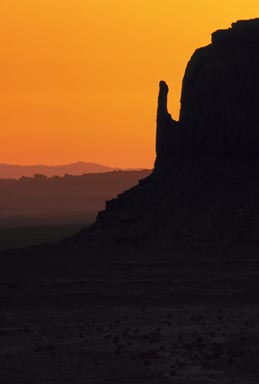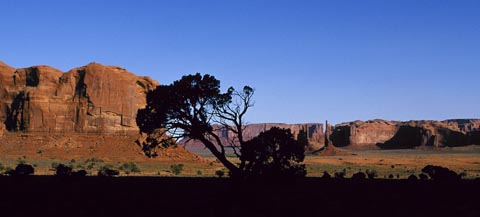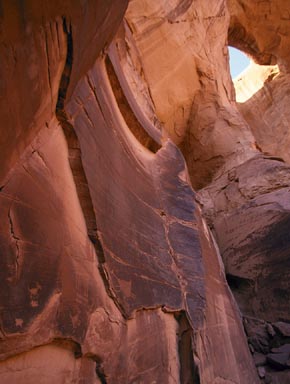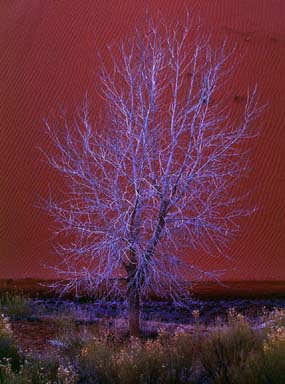Note: The photographs and text below are from a trip taken in April, 1999. A year later in April, 2000 I lead a landscape photography workshop to this same location. For a portfolio of images from that trip, as well as work by some of the workshop’s students and co-instructor Steve Kossack, please seeMonument Valley 2000.
A visit toCanyon de Chellydone on the same trip will be of interest.
So, you want to get away from it all. If so, then these are the places to go. In addition to being about as far from civilization as you can get in the lower 48 states, they also happen to be two of the most spectacular locations for photography in the Southwest.
As usual when planning a trip like this I highly recommend reading Robert Hitchman’sPhotograph Americaguides; in this case #27 from Nov/Dec 1993. I won’t attempt to replicate here the excellent job that Hitchman does, but instead offer some personal experiences and anecdotes.
Yellow Stripe Hwy, outside Monument Valley, 1999
Taken with aCanon EOS3and Canon 24mm L T/S f/3.5 lens on Provia 100 west of Monument Valley.
Getting There
Monument Valley lies roughly equidistant from Las Vegas, Phoenix, Salt Lake City and Santa Fe. By using Las Vegas as a gateway though I was able to spend the evening of the first travel day at the south rim of the Grand Canyon, adding a bonus stop-off to the trip. If you are going to over-night at the Grand Canyon be sure to book lodgings far in advance — especially during the busy summer months.
As for where to stay in Monument Valley,Gouldings Trading Post and Lodge(435/727-3231) is it. This motel complex is just a couple of miles from the entrance to the Valley. Again, book early during the tourist months.
Monument Valley
This isnota National Park. Operated by the Navaho Tribal Council you’ll find that the rules of the game are somewhat different. There is a road through the Valley that is open to public vehicles (4 wheel drive isn’t needed) but the hours are limited anddo notinclude sunrise and sunset access. There is a small entrance fee.
The Mittens — Monument Valley, 1999
Photographed with a CanonEOS3and Canon L 28~70mm f/2.8 zoom on Provia 100.
The place to shoot sunrise is from the visitors centre. (The photograph above was taken from there.) We were there for sunrise and afterward drove back to Gouldings for a shower and breakfast. We then returned for when the park gates opened and spent several hours shooting from the public road within the valley.
The day before though, when we arrived, we hired a Navaho guide who drove us through the valley. This allowed us to stay after closing and to shoot through sunset. It also lets you reach areas of the park that are otherwise inaccessible. Hiring a guide is therefore a must, but not inexpensive. The guide/driver and vehicle (they insist), cost us $150 for 4 hours, and this was after some bargaining. There is no shortage of guides but choosing the right one can be problematic. Make sure that you get someone that is familiar with the best locations for photography. Also, use the facilities before leaving the visitors centre and bring water and snacks, because there are absolutely no facilities within the Valley.
 Center Mitten — Monument Valley, 1999
Center Mitten — Monument Valley, 1999
Taken with a CanonEOS3and Canon L IS 100~400 zoom on Provia 100
Taken just minutes after the frame above, with my longest lens at about 400mm. A pale yellow warming filter was used to enhance the warmth of the sky; the rest was provided by mother-nature. The special quality of the light only lasts for a very brief time. Sometimes that’s the end of shooting for the day — or at least until late afternoon.
 Tree & Panorama — Monument Valley, 1999
Tree & Panorama — Monument Valley, 1999
Photographed with a CanonEOS3and Canon L 28~70mm f/2.8 zoom on Provia 100.
I almost always preach against shooting in bright sunlight. Seldom does the quality of the light compliment the subject matter. In this case the foreground trees were in deep shade, caused by an intervening butte, and they created the contrast of tones and shapes that make this image work.
I enjoy shooting with wide-format cameras. I currently use aFuji 617as well as aHasselblad XPan. But on this trip I had neither with me, just my Canon EOS system. So when this panoramic silhouette presented itself I shot it with what I had and created the wide format perspective by cropping the frame.
 Petroglyphs and Window — Monument Valley, 1999
Petroglyphs and Window — Monument Valley, 1999
Photographed with a Canon EOS 3 and 17~35mm f/2.8 L lens
The range of subject matter available is remarkable. There are a number of "window" rocks within the park and our guide brought us to see and photograph this one. We were amazed and pleased when we discovered that the best view also included a very beautiful collection of petroglyphs. Click on the picture above, orHEREto see an enlarged image. This shot required my widest lens, 17mm, and I was pleased to discover that I was able to retain good detail in both the shadow as well as highlight areas.
When shooting in Monument Valley don’t just restrict yourself to the grand vistas. While these are compelling, they are also clichéd. (You’ve seen them in many John Wayne movies.) There is a wealth of detail to be found so don’t hesitate to do some hiking. (Unless you’re with a guide you are restricted to driving on the valley road, but there is no restriction on short hikes from the road and parking areas).
 Red Dunes and Tree, Monument Valley, 1999
Red Dunes and Tree, Monument Valley, 1999
To paraphrase the aphorism "truth is stranger than fiction, in this case reality is stranger than digital enhancement. Taken about 40 minutes after sunset, the eye’s ability to see colour was fading fast but an exposure of approximately 30 seconds produced this image. There may have been some minor colour shift due to reciprocity failure but the sand really is close to this colour.Hereis another photograph taken that same evening.
Note: The photographs and text above are from a trip taken in April, 1999. A year later in April, 2000 I lead a landscape photography workshop to this same location. For a portfolio of images from that trip, as well as work by some of the workshop’s students and co-instructor Steve Kossack, please seeMonument Valley 2000.
